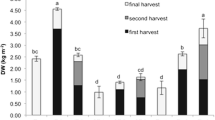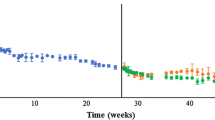Abstract
High alkalinity (pH > 12) of bauxite-residue leachates presents challenges for the long-term storage and managements of the residue. Recent evidence has highlighted the potential for constructed wetlands to effectively buffer the alkalinity, but there is limited evidence on the potential for wetland plants to establish and grow in soils inundated with residue leachate. A pot-based trial was conducted to investigate the potential for Phragmites australis to establish and grow in substrate treated with residue leachate over a pH range of 8.6–11.1. The trial ran for 3 months, after which plant growth and biomass were determined. Concentrations of soluble and exchangeable trace elements in the soil substrate and also in the aboveground and belowground biomass were determined. Residue leachate pH did not affect plant biomass or microbial biomass. With the exception of Na, there was no effect on exchangeable trace elements in the substrate; however, increases in soluble metals (As, Cd and Na) were observed with increasing leachate concentration. Furthermore, increases in Al, As and V were observed in belowground biomass and for Cd and Cr in aboveground biomass. Concentrations within the vegetation biomass were less than critical phytotoxic levels. Results demonstrate the ability for P. australis to grow in bauxite-residue leachate-inundated growth media without adverse effects.





Similar content being viewed by others
References
Allen SE (1989) Chemical analysis of ecological material, 2nd edn. Blackwell Scientific Publications, Oxford, p. 368
Allen SE, Pearsall W (1963) Leaf analysis and shoot production in phragmites. Oikos 14:176–189
Allende KL, McCarthy DT, Fletcher TD (2014) The influence of media type on removal of arsenic, iron and boron from acidic wastewater in horizontal flow wetland microcosms planted with Phragmites australis. Chem Eng J 246:217–228
Baker AJ (2000) Metal hyperaccumulator plants: a review of the biological resource for possible exploitation in the phytoremediaton of metal-polluted soils. In: Terry N, Baneulos GS (eds) Phytoremediation of contaminated soil and water. CRC Press, Boca Raton, FL, pp. 85–107
Banks MK, Schwab AP, Alleman JE, Hunter JG, Hickey JC (2006) Constructed wetlands for the remediation of blast furnace slag leachates. Joint Transportation Research Program, Indiana
Batty LC, Younger PL (2004) Growth of Phragmites australis (Cav.) Trin ex. Steudel in mine water treatment wetlands: effects of metal and nutrient uptake. Environ Pollut 132:85–93
Bonanno G (2011) Trace element accumulation and distribution in the organs of Phragmites australis (common reed) and biomonitoring applications. Ecotox Environ Safe 74:1057–1064
Bonanno G, Giudice RL (2010) Heavy metal bioaccumulation by the organs of Phragmites australis (common reed) and their potential use as contamination indicators. Ecol Indic 10:639–645
Bragato C, Brix H, Malagoli M (2006) Accumulation of nutrients and heavy metals in Phragmites australis (Cav.) Trin. Ex Steudel and Bolboschoenus maritimus (L.) Palla in a constructed wetland of the Venice lagoon watershed. Environ Pollut 144:967–975
Buckley R, Curtin T, Courtney R (2016) The potential for constructed wetlands to treat alkaline bauxite residue leachate: laboratory investigations. Environ Sci Pollut Res 23:14115–14122
Burke IT, Mayes WM, Peacock CL, Brown AP, Jarvis AP, Gruiz K (2012) Speciation of arsenic, chromium, and vanadium in red mud samples from the Ajka spill site, Hungary. Environ Sci Technol 46:3085–3092
Burke IT, Peacock CL, Lockwood CL, Stewart DI, Mortimer RJ, Ward MB, Renforth P, Gruiz K, Mayes WM (2013) Behavior of aluminum, arsenic, and vanadium during the neutralization of red mud leachate by HCl, gypsum, or seawater. Environ Sci Technol 47:6527–6535
Chaney RL (1989) Toxic element accumulation in soils and crops: protecting soil fertility and agricultural food chains. In: Bar-Yosef B, Barrow NJ, Goldshmid J (eds) Inorganic contaminants in the Vadose zone. Springer-Verlag, Berlin, pp. 140–158
Courtney R, Mullen G (2009) Use of germination and seedling performance bioassays for assessing revegetation strategies on bauxite residue. Water Air Soil Pollut 197:15–22
Czop M, Motyka J, Sracek O, Szuwarzyński M (2011) Geochemistry of the hyperalkaline Gorka pit Lake (pH > 13) in the Chrzanow region, southern Poland. Water Air Soil Pollut 214:423–434
Hua T, Haynes RJ, Zhou YF, Boullemant A, Chandrawana I (2015) Potential for use of industrial waste materials as filter media for removal of Al, Mo, As, V and Ga from alkaline drainage in constructed wetlands–adsorption studies. Water Res 71:32–41
Jenkinson DS, Powlson DS (1976) The effects of biocidal treatments on metabolism in soil—I. Fumigation with chloroform. Soil Biol Biochem 8:167–177
Joergensen R, Wichern F (2008) Quantitative assessment of the fungal contribution to microbial tissue in soil. Soil Biol Biochem 40:2977–2991
Kabata-Pendias A, Pendias H (2001) Trace element in soils and plants, 3rd edn. CRC Press, Boca Raton
Klauber C, Gräfe M, Power G (2011) Bauxite residue issues: II. Options for residue utilization. Hydrometallurgy 108:11–32
Lawson CJ (2004) A preliminary analysis into the use of passive remediation in calcareous alkaline waters, Unpublished MSc. thesis. University of Newcastle upon Tyne
Lehoux AP, Lockwood CL, Mayes WM, Stewart DI, Mortimer RJ, Gruiz K, Burke IT (2013) Gypsum addition to soils contaminated by red mud: implications for aluminium, arsenic, molybdenum and vanadium solubility. Environ Geochem Health 35:643–656
Lesage E, Rousseau DPL, Meers E, Tack FMG, De Pauw N (2007) Accumulation of metals in a horizontal subsurface flow constructed wetland treating domestic wastewater in Flanders, Belgium. Sci Total Environ 380:102–115
Lippert I, Rolletschek H, Kohl JG (2001) Photosynthetic pigments and efficiencies of two Phragmites australis stands in different nitrogen availabilities. Aquat Bot 69:359–365
Matthews DJ, Moran BM, Otte ML (2005) Screening the wetland plant species Alisma plantago-aquatica, Carex rostrata and Phalaris arundinacea for innate tolerance to zinc and comparison with Eriophorum angustifolium and Festuca rubra Merlin. Environ Pollut 134:43–351
Mayes WM, Younger PL, Aumônier J (2008) Hydrogeochemistry of alkaline steel slag leachates in the UK. Water Air Soil Pollut 195:35–50
Mayes WM, Batty LC, Younger PL, Jarvis AP, Kõiv M, Vohla C, Mander U (2009) Wetland treatment at extremes of pH: a review. Sci Total Environ 407:3944–3957
Mayes WM, Jarvis AP, Burke IT, Walton M, Feigl V, Klebercz O, Gruiz K (2011) Dispersal and attenuation of trace contaminants downstream of the Ajka bauxite residue (red mud) depository failure, Hungary. Environ Sci Technol 45:5147–5155
Mišík M, Burke IT, Reismüller M, Pichler C, Rainer B, Mišíková K, Mayes WM, Knasmueller S (2014) Red mud a byproduct of aluminum production contains soluble vanadium that causes genotoxic and cytotoxic effects in higher plants. Sci Total Environ 493:883–890
Peacock CL, Sherman DM (2004) Vanadium (V) adsorption onto goethite (α-FeOOH) at pH 1.5 to 12: a surface complexation model based on ab initio molecular geometries and EXAFS spectroscopy. Geochim Cosmochim Acta 68:1723–1733
Qian Y, Gallagher FJ, Feng H, Wu M, Zhu Q (2014) Vanadium uptake and translocation in dominant plant species on an urban coastal brownfield site. Sci Total Environ 476:696–704
Ruyters S, Mertens J, Vassilieva E, Dehandschutter B, Poffijn A, Smolders E (2011) The red mud accident in Ajka (Hungary): plant toxicity and trace metal bioavailability in red mud contaminated soil. Environ Sci Technol 45:1616–1622
Truu M, Juhanson J, Truu J (2009) Microbial biomass, activity and community composition in constructed wetlands. Sci Total Environ 407:3958–3971
Vance ED, Brookes PC, Jenkinson DS (1987) An extraction method for measuring soil microbial biomass C. Soil Biol Biochem 19:703–707
Vymazal J (2005) Horizontal sub-surface flow and hybrid constructed wetlands systems for wastewater treatment. Ecol Eng 25:478–490
Vymazal J, Šveha J (2012) Removal of alkali metals and their sequestration in plants in constructed wetlands treating municipal sewage. Hydrobiologia 692:131–143
Vymazal J, Švehla J, Kröpfelová L, Chrastný V (2007) Trace metals in Phragmites australis and Phalaris arundinacea growing in constructed and natural wetlands. Sci Total Environ 380:154–162
Vymazal J, Kröpfelová L, Švehla J, Chrastný V, Štíchová J (2009) Trace elements in Phragmites australis growing in constructed wetlands for treatment of municipal wastewater. Ecol Eng 35:303–309
Wang X, Zhang Y, Lv F, An Q, Lu R, Hu P, Jiang S (2015) Removal of alkali in the red mud by SO2 and simulated flue gas under mild conditions. Environ Prog Sustain Energy 34:81–87
Acknowledgments
This research was supported by funding from the International Aluminium Institute.
Author information
Authors and Affiliations
Corresponding author
Additional information
Responsible editor: Roberto Terzano
Rights and permissions
About this article
Cite this article
Higgins, D., Curtin, T., Pawlett, M. et al. The potential for constructed wetlands to treat alkaline bauxite-residue leachate: Phragmites australis growth. Environ Sci Pollut Res 23, 24305–24315 (2016). https://doi.org/10.1007/s11356-016-7702-1
Received:
Accepted:
Published:
Issue Date:
DOI: https://doi.org/10.1007/s11356-016-7702-1




